SBVS273A June 2016 – September 2016 TPS3779-Q1 , TPS3780-Q1
PRODUCTION DATA.
- 1 Features
- 2 Applications
- 3 Description
- 4 Revision History
- 5 Device Comparison Table
- 6 Pin Configuration and Functions
- 7 Specifications
- 8 Detailed Description
- 9 Application and Implementation
- 10Power-Supply Recommendations
- 11Layout
- 12Device and Documentation Support
- 13Mechanical, Packaging, and Orderable Information
Package Options
Mechanical Data (Package|Pins)
- DBV|6
Thermal pad, mechanical data (Package|Pins)
Orderable Information
7 Specifications
7.1 Absolute Maximum Ratings
over operating junction temperature range (unless otherwise noted)(1)| MIN | MAX | UNIT | ||
|---|---|---|---|---|
| Voltage | VDD | –0.3 | 7 | V |
| OUT1, OUT2 (TPS3779-Q1 only) | –0.3 | VDD + 0.3 | ||
| OUT1, OUT2 (TPS3780-Q1 only) | –0.3 | 7 | ||
| SENSE1, SENSE2 | –0.3 | 7 | ||
| Current | OUT1, OUT2 | ±20 | mA | |
| Temperature | Operating junction, TJ(2) | –40 | 125 | °C |
| Storage, Tstg | –65 | 150 | ||
(1) Stresses beyond those listed under Absolute Maximum Ratings may cause permanent damage to the device. These are stress ratings only, which do not imply functional operation of the device at these or any other conditions beyond those indicated under Recommended Operating Conditions. Exposure to absolute-maximum-rated conditions for extended periods may affect device reliability.
(2) For low-power devices, the junction temperature rise above the ambient temperature is negligible; therefore, the junction temperature is considered equal to the ambient temperature (TJ = TA).
7.2 ESD Ratings
| VALUE | UNIT | |||
|---|---|---|---|---|
| V(ESD) | Electrostatic discharge | Human-body model (HBM), per AEC Q100-002(1) | ±2000 | V |
| Charged-device model (CDM), per AEC Q100-011 | ±500 | |||
(1) AEC Q100-002 indicates that HBM stressing shall be in accordance with the ANSI/ESDA/JEDEC JS-001 specification.
7.3 Recommended Operating Conditions
over operating junction temperature range (unless otherwise noted)| MIN | NOM | MAX | UNIT | |||
|---|---|---|---|---|---|---|
| Power-supply voltage | 1.5 | 5.5 | V | |||
| Sense voltage | SENSE1, SENSE2 | 0 | 5.5 | V | ||
| Output voltage (TPS3779-Q1 only) | OUT1, OUT2 | 0 | VDD + 0.3 | V | ||
| Output voltage (TPS3780-Q1 only) | OUT1, OUT2 | 0 | 5.5 | V | ||
| RPU | Pullup resistor (TPS3780-Q1 only) | 1.5 | 10,000 | kΩ | ||
| Current | OUT1, OUT2 | –5 | 5 | mA | ||
| CIN | Input capacitor | 0.1 | µF | |||
| TJ | Junction temperature | –40 | 25 | 125 | °C | |
7.4 Thermal Information
| THERMAL METRIC(1) | TPS3779-Q1, TPS3780-Q1 | UNIT | |
|---|---|---|---|
| DBV (SOT-23) | |||
| 6 PINS | |||
| RθJA | Junction-to-ambient thermal resistance | 193.9 | °C/W |
| RθJC(top) | Junction-to-case (top) thermal resistance | 134.5 | °C/W |
| RθJB | Junction-to-board thermal resistance | 39.0 | °C/W |
| ψJT | Junction-to-top characterization parameter | 30.4 | °C/W |
| ψJB | Junction-to-board characterization parameter | 38.5 | °C/W |
| RθJC(bot) | Junction-to-case (bottom) thermal resistance | N/A | °C/W |
(1) For more information about traditional and new thermal metrics, see the Semiconductor and IC Package Thermal Metrics application report.
7.5 Electrical Characteristics
all specifications are over the operating temperature range of –40°C < TJ < +125°C and 1.5 V ≤ VDD ≤ 5.5 V (unless otherwise noted); typical values are at TJ = 25°C and VDD = 3.3 V| PARAMETER | TEST CONDITIONS | MIN | TYP | MAX | UNIT | ||
|---|---|---|---|---|---|---|---|
| VDD | Input supply range | 1.5 | 5.5 | V | |||
| V(POR) | Power-on-reset voltage(1) | VOL (max) = 0.2 V, IOL = 15 µA | 0.8 | V | |||
| IDD | Supply current (into VDD pin) | VDD = 3.3 V, no load | 2.09 | 5.80 | µA | ||
| VDD = 5.5 V, no load | 2.29 | 6.50 | |||||
| VIT+ | Positive-going input threshold voltage | V(SENSEx) rising | 1.194 | V | |||
| –1% | 1% | ||||||
| VIT– | Negative-going input threshold voltage | V(SENSEx) falling | TPS37xxA-Q1 (0.5% hysteresis) |
1.188 | V | ||
| TPS37xxB-Q1 (5% hysteresis) |
1.134 | ||||||
| TPS37xxC-Q1 (10% hysteresis) |
1.074 | ||||||
| V(SENSEx) falling | –1% | 1% | |||||
| I(SENSEx) | Input current | V(SENSEx) = 0 V or VDD | –15 | 15 | nA | ||
| VOL | Low-level output voltage | VDD ≥ 1.5 V, ISINK = 0.4 mA | 0.25 | V | |||
| VDD ≥ 2.7 V, ISINK = 2 mA | 0.25 | ||||||
| VDD ≥ 4.5 V, ISINK = 3.2 mA | 0.30 | ||||||
| VOH | High-level output voltage (TPS3779-Q1 only) |
VDD ≥ 1.5 V, ISOURCE = 0.4 mA | 0.8 VDD | V | |||
| VDD ≥ 2.7 V, ISOURCE = 1 mA | 0.8 VDD | ||||||
| VDD ≥ 4.5 V, ISOURCE = 2.5 mA | 0.8 VDD | ||||||
| Ilkg(OD) | Open-drain output leakage current (TPS3780-Q1 only) | High impedance, V(SENSEx) = V(OUTx) = 5.5 V | –250 | 250 | nA | ||
(1) Outputs are undetermined below V(POR).
7.6 Timing Requirements
typical values are at TJ = 25°C and VDD = 3.3 V; SENSEx transitions between 0 V and 1.3 V| MIN | NOM | MAX | UNIT | ||
|---|---|---|---|---|---|
| tPD(r) | SENSEx (rising) to OUTx propagation delay | 5.5 | µs | ||
| tPD(f) | SENSEx (falling) to OUTx propagation delay | 10 | µs | ||
| tSD | Startup delay(1) | 570 | µs | ||
(1) During power-on or when a VDD transient is below VDD(min), the outputs reflect the input conditions 570 µs after VDD transitions through VDD(min).
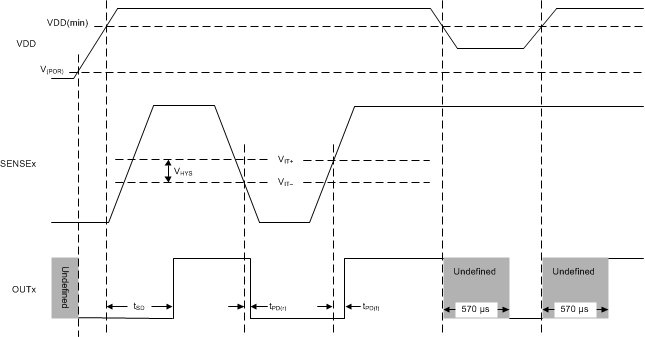 Figure 1. Timing Diagram
Figure 1. Timing Diagram
7.7 Typical Characteristics
at TJ = 25°C with a 0.1-µF capacitor close to VDD (unless otherwise noted)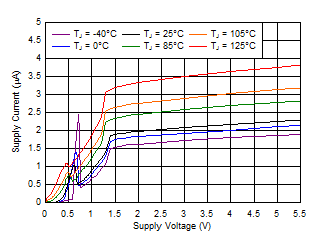
| SENSE1 = SENSE2 = 1.5 V |
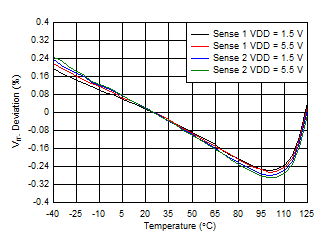
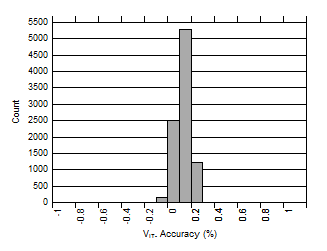
| VDD = 5.5 V |
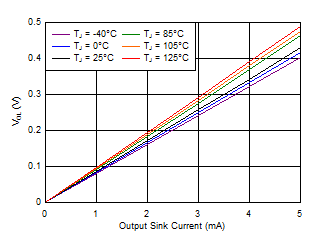
(VDD = 3.3 V)
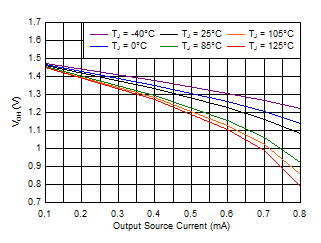
(VDD = 1.5 V)
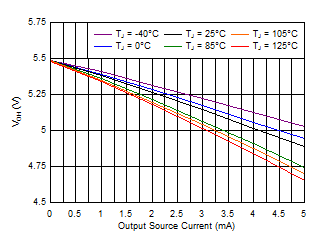
(VDD = 5.5 V)
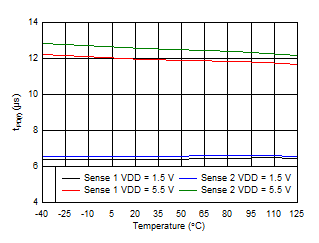
| SENSE1 = SENSE2 = 1.3 V to 0 V |
SENSEx Low to Output Low
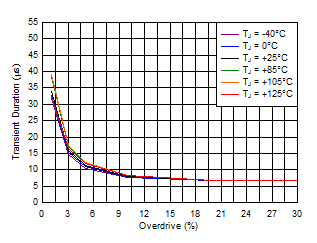
| High-to-low transition occurs above the curve |
(VDD = 1.5 V)
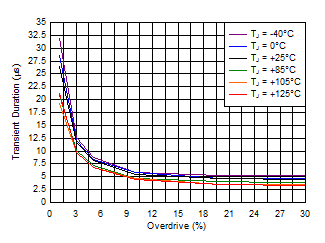
| Low-to-high transition occurs above the curve |
(VDD = 1.5 V)
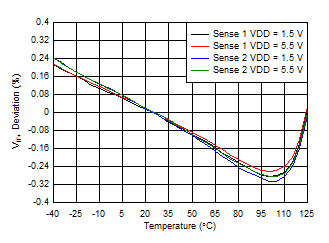
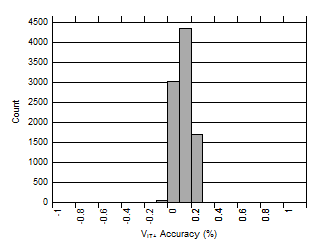
| VDD = 5.5 V |
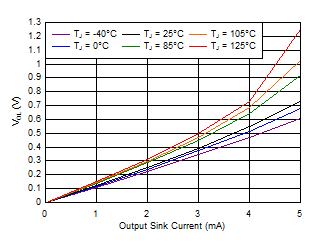
(VDD = 1.5 V)
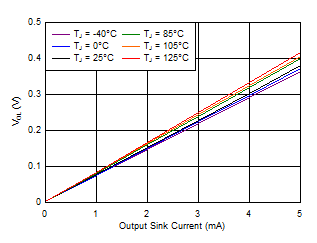
(VDD = 5.5 V)
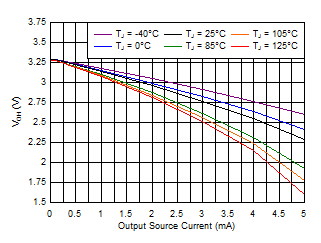
(VDD = 3.3 V)
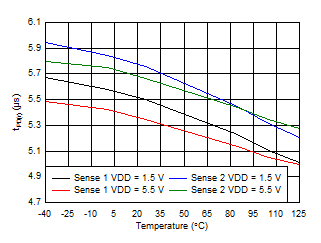
| SENSE1 = SENSE2 = 0 V to 1.3 V |
SENSEx High to Output High
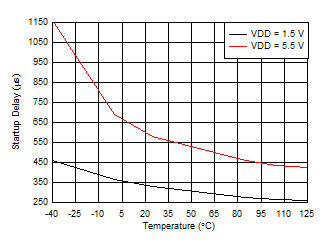
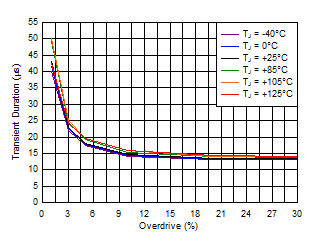
| High-to-low transition occurs above the curve |
(VDD = 5.5 V)
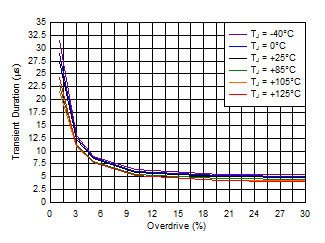
| Low-to-high transition occurs above the curve |
(VDD = 5.5 V)